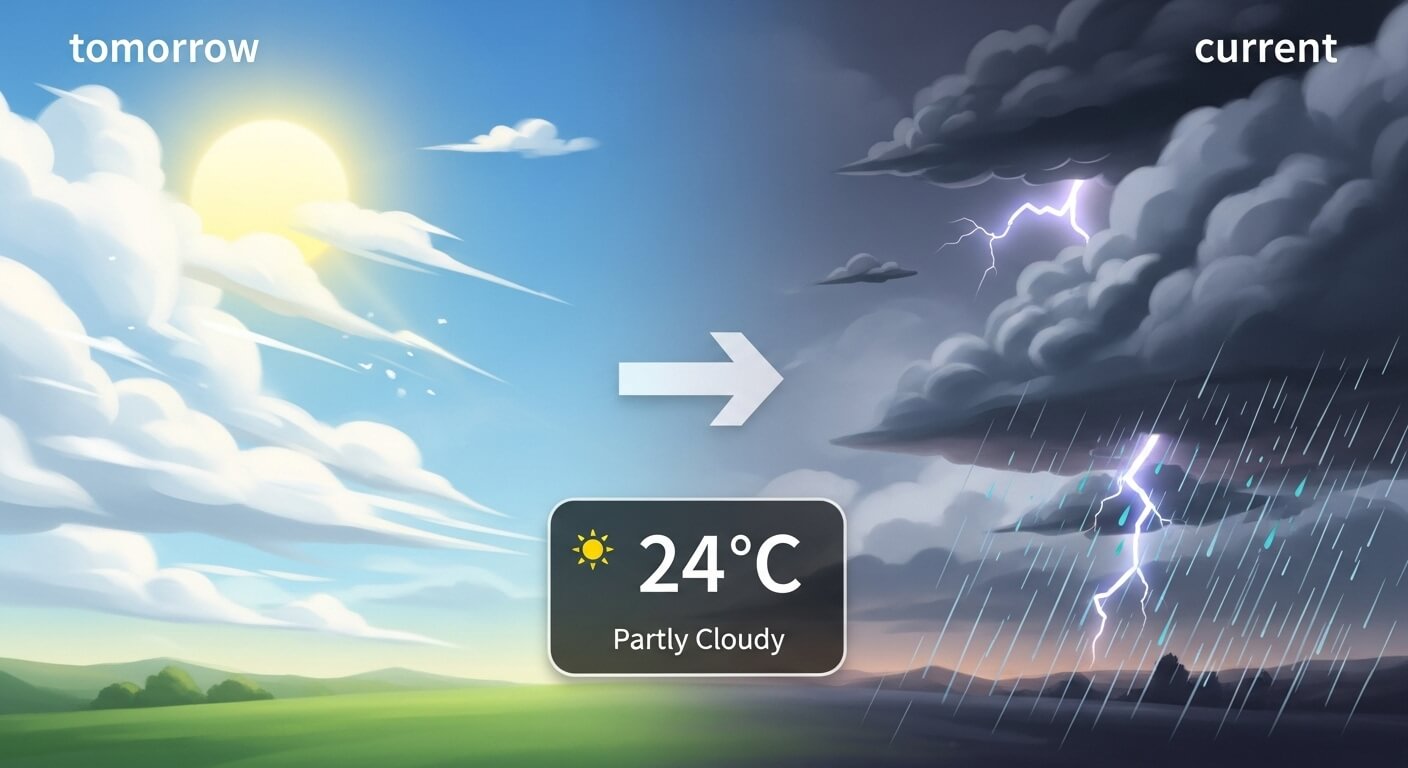Introduction to Tomorrow’s Weather and Its Importance
Knowing tomorrow’s weather is critical for planning daily activities, ensuring safety, and optimizing productivity. As we approach August 23, 2025, global weather patterns reflect late-summer transitions in the Northern Hemisphere and mild winter conditions in the Southern Hemisphere. Whether you’re organizing an outdoor event, commuting, or managing crops, accurate forecasts empower informed decisions. This comprehensive guide explores the science of predicting tomorrow’s weather, offers city-specific outlooks for August 23, 2025, and provides tools to stay updated.
The term “weather tomorrow” refers to the anticipated atmospheric conditions for the next day, including temperature, precipitation, wind, humidity, and air quality. With modern meteorology achieving over 90% accuracy for short-term forecasts, you can rely on these predictions for precision. In 2025, advancements in AI and data collection have further refined daily outlooks, helping users navigate increasingly variable climate patterns. For instance, warmer-than-average temperatures are expected in many regions tomorrow, with potential for isolated storms due to seasonal shifts.
This article covers how forecasts are made, key influencing factors, detailed predictions for major cities, recommended apps, climate change impacts, and answers to common questions. By understanding these elements, you’ll be equipped to plan effectively and adapt to tomorrow’s conditions, whether you’re a traveler, parent, or business owner.
The Science Behind Weather Forecasting: How Predictions Are Made
Weather forecasting combines observation, analysis, and computation to predict atmospheric conditions. It starts with collecting real-time data from weather stations, satellites, buoys, and aircraft, measuring variables like temperature, pressure, humidity, and wind speed. These observations feed into numerical weather prediction (NWP) models, which solve complex equations based on physics to simulate future atmospheric behavior.
For tomorrow’s weather, short-range models like the High-Resolution Rapid Refresh (HRRR) provide hourly updates, accurate within 1-2 degrees Fahrenheit for temperature. Ensemble forecasting enhances reliability by running multiple simulations with slight variations, producing probability-based outlooks (e.g., “70% chance of rain”). Historical data refines these models by identifying patterns; for example, if current conditions resemble a past rainy day, predictions adjust accordingly.
In 2025, AI has revolutionized forecasting by processing vast datasets faster, improving accuracy for complex phenomena like thunderstorms. Major organizations like the National Weather Service (NWS) and the European Centre for Medium-Range Weather Forecasts (ECMWF) integrate global models for high precision. For August 23, 2025, neutral El Niño-Southern Oscillation (ENSO) conditions suggest stable patterns, though regional variations persist.
Human meteorologists play a vital role, refining model outputs with local expertise. While chaos theory limits long-term predictions, tomorrow’s forecasts are highly reliable due to dense data networks and advanced computing. This synergy ensures actionable insights for daily planning.
Key Factors Influencing Tomorrow’s Weather Forecasts
Tomorrow’s weather is shaped by interconnected atmospheric and geographic factors. Temperature, driven by solar radiation and air masses, varies with cloud cover and seasonal angles—August’s high sun drives warmth in the Northern Hemisphere. Atmospheric pressure influences wind and storm formation; high pressure brings clear skies, while low pressure invites clouds and rain. Humidity affects comfort and precipitation likelihood, with high levels amplifying heat perception. Wind, shaped by pressure gradients and terrain, transports air masses, cooling or warming regions.
Precipitation forms when moist air rises, cools, and condenses, often triggered by fronts or mountains. Jet stream positions can steer storms, as seen in recent US weather patterns. Local geography matters: coastal areas experience milder temperatures due to marine influences, while inland regions see greater swings. Urban heat islands, where cities retain heat, can elevate local temperatures by 2-5°F.
Climate change intensifies these dynamics, increasing the frequency of extreme heat, storms, and unpredictable shifts. For August 23, 2025, neutral ENSO conditions suggest typical late-summer weather, but recent hurricane activity may influence some regions. Data quality is critical; areas with fewer observation stations face less accurate forecasts. Understanding these factors helps interpret why tomorrow might bring sun in one city and rain in another.
Global Overview of Weather Tomorrow: August 23, 2025
On August 23, 2025, global weather reflects seasonal transitions. The Northern Hemisphere, in late summer, sees warmer-than-average temperatures, with highs in the 70s-90s°F across the US and Asia. Isolated thunderstorms are possible in equatorial and southern US regions due to lingering moisture. Europe anticipates cooler, showery conditions, while Australia, in winter, expects mild, dry days. Neutral ENSO conditions stabilize patterns, but regional variations—driven by local geography and recent weather events like hurricanes—create diverse outlooks. This global snapshot sets the stage for city-specific forecasts, highlighting how large-scale systems shape local conditions.
Detailed Weather Forecasts for Major Cities on August 23, 2025
New York, USA
- Forecast: Mostly sunny, high of 82°F (28°C), low of 70°F (21°C), winds at 6 mph, humidity 39%.
- Details: No significant rain expected, aligning with August averages (68-82°F, 3-8 rainy days monthly). Ideal for outdoor activities, but urban heat may elevate perceived temperatures. Monitor air quality if sensitive.
London, UK
- Forecast: Partly cloudy with possible light showers, high of 66°F (19°C), low of 64°F (18°C), winds at 8 mph, humidity 54%.
- Details: Typical for August’s 3-8 rainy days. Bank holiday weekend vibes favor dry but overcast conditions. Carry an umbrella for brief showers.
Tokyo, Japan
- Forecast: Hot and overcast, high of 91°F (33°C), low of 82°F (28°C), winds at 14 mph, humidity 67%.
- Details: Isolated thunderstorms possible, consistent with August’s hot, humid averages (77-87°F). Stay hydrated and avoid midday heat exposure.
Sydney, Australia
- Forecast: Clear skies, high of 68°F (20°C), low of 55°F (13°C), winds SE at 5 mph, minimal rain (0.3 mm earlier).
- Details: Mild winter day, typical for August. Perfect for outdoor plans, with stable conditions expected.
Los Angeles, USA
- Forecast: Sunny and hot, high of 91°F (33°C), low of 72°F (22°C), winds 7 mph, humidity 23%.
- Details: Dry, warm weather aligns with August norms. Great for beach or hiking, but use sunscreen due to high UV index.
These forecasts are based on current models and may shift slightly; check local sources for real-time updates.
Best Tools and Apps for Accurate Weather Tomorrow Forecasts in 2025
Reliable apps are essential for staying updated. Here are top picks for 2025:
- AccuWeather: Offers MinuteCast for minute-by-minute rain predictions, superior radar, and health-related alerts (e.g., pollen levels). Highly accurate for short-term forecasts.
- Weather Underground: Combines hyper-local data from personal weather stations with detailed maps. Ideal for precise, neighborhood-level forecasts.
- The Weather Channel: User-friendly with robust radar and severe weather alerts. Includes lifestyle indices (e.g., running conditions).
- Ventusky: Visualizes wind, waves, and precipitation with interactive maps. Great for coastal or travel planning.
- NOAA Weather: Direct access to NWS data, best for raw, unfiltered forecasts. Preferred by professionals.
For iOS and Android, ensure auto-updates are enabled for real-time data. Many apps now integrate AI for personalized alerts, like heat warnings for vulnerable users. Cross-check multiple sources for critical plans, as models can differ slightly.
Climate Change and Its Impact on Tomorrow’s Weather
Climate change amplifies weather variability, making tomorrow’s forecasts more complex. Rising global temperatures, up 1.1°C since pre-industrial times, increase heatwave frequency and intensity. In 2025, this translates to hotter August days, with cities like Tokyo and Los Angeles seeing highs above historical norms. Extreme precipitation events are also rising; storms tomorrow may carry heavier rain due to increased atmospheric moisture.
Urban heat islands exacerbate local warming, affecting city-specific forecasts. Coastal areas face higher humidity, while inland regions see wider temperature swings. Climate models predict more frequent “weather whiplash”—rapid shifts from hot to stormy—complicating daily predictions. For August 23, 2025, neutral ENSO reduces major disruptions, but localized extremes persist.
To adapt, use apps with climate-informed alerts and monitor long-term trends for seasonal planning. Sustainable practices, like reducing emissions, can mitigate future impacts, ensuring more predictable tomorrows.
Troubleshooting Weather Forecast Issues
Even with advanced tech, forecast issues arise. Here’s how to handle common problems:
- Inaccurate App Forecasts: Cross-reference apps like AccuWeather and NOAA. Discrepancies often stem from model differences or outdated data. Update apps regularly.
- Location Errors: Ensure GPS is enabled and location permissions are granted. Manually set your city if auto-detection fails.
- Delayed Updates: Server lags or poor internet can delay data. Restart the app or switch to Wi-Fi. Check time stamps for freshness.
- Conflicting Predictions: Models like ECMWF and GFS may diverge. Trust local weather services (e.g., NWS) for refined outlooks.
- Severe Weather Alerts Missing: Enable push notifications and check regional warnings, especially for storms or heatwaves.
If issues persist, visit official weather service websites for direct model outputs.
Frequently Asked Questions: High-Volume Queries Answered
- How Accurate Are Tomorrow’s Weather Forecasts?
Short-term forecasts are over 90% accurate for temperature and precipitation, thanks to dense data networks and AI models. Minor errors may occur with sudden microclimate changes. - Why Do Weather Apps Show Different Forecasts for Tomorrow?
Apps use different models (e.g., GFS vs. ECMWF) or update cycles. Local data integration also varies. Compare multiple sources for consensus. - How Can I Prepare for Tomorrow’s Weather?
Check forecasts early, pack for conditions (e.g., umbrellas, sunscreen), and adjust plans for extremes like heat or storms. Use apps with real-time alerts. - What’s the Best Weather App for Tomorrow’s Forecast?
AccuWeather and Weather Underground excel for short-term accuracy. NOAA Weather is ideal for unfiltered data. Choose based on interface preference. - How Does Climate Change Affect Tomorrow’s Weather?
It increases extremes, like hotter days or heavier rain. For August 23, 2025, expect warmer-than-average conditions in many regions. - Can I Trust Free Weather Apps?
Yes, reputable ones like The Weather Channel or NOAA are reliable. Avoid unverified apps with poor data sources. - What If Tomorrow’s Forecast Changes Overnight?
Short-term forecasts stabilize closer to the date. Check apps in the morning for updates, especially for precipitation or wind shifts. - How to Get Hyper-Local Weather for Tomorrow?
Use Weather Underground for crowd-sourced station data or enable precise location tracking in apps like AccuWeather.
Conclusion
Understanding tomorrow’s weather for August 23, 2025, equips you to plan confidently, from daily commutes to major events. With accurate forecasts, advanced apps, and awareness of climate impacts, you can navigate any conditions. Stay proactive by checking real-time updates and leveraging tools to ensure safety and comfort.
Editor of The Best Update, with over 10 years of writing experience, delivering insightful, well-researched, and engaging content across diverse topics to keep readers informed and inspired.




